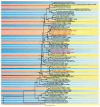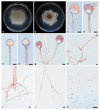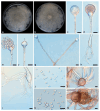Unveiling Species Diversity Within Early-Diverging Fungi from China VI: Four Absidia sp. nov. (Mucorales) in Guizhou and Hainan
- PMID: 40572203
- PMCID: PMC12195128
- DOI: 10.3390/microorganisms13061315
Unveiling Species Diversity Within Early-Diverging Fungi from China VI: Four Absidia sp. nov. (Mucorales) in Guizhou and Hainan
Abstract
Absidia is the most species-rich genus within the family Cunninghamellaceae, with its members commonly isolated from diverse substrates, particularly rhizosphere soil. In this study, four novel Absidia species, A. irregularis sp. nov., A. multiformis sp. nov., A. ovoidospora sp. nov., and A. verticilliformis sp. nov., were discovered from soil samples collected in southern and southwestern China, using integrated morphological and molecular analyses. Phylogenetic analyses based on concatenated ITS, SSU, LSU, Act, and TEF1α sequence data reconstructed trees that strongly supported the monophyly of each of these four new taxa. Key diagnostic features include A. irregularis (closely related to A. oblongispora) exhibiting irregular colony morphology, A. multiformis (sister to A. heterospora) demonstrating polymorphic sporangiospores, A. ovoidospora (forming a clade with A. panacisoli and A. abundans) producing distinctive ovoid sporangiospores, and A. verticilliformis (next to A. edaphica) displaying verticillately branched sporangiophores. Each novel species is formally described with comprehensive documentation, including morphological descriptions, illustrations, Fungal Names registration identifiers, designated type specimens, etymological explanations, maximum growth temperatures, and taxonomic comparisons. This work constitutes the sixth instalment in a series investigating early-diverging fungal diversity in China aiming to enhance our understanding of the diversity of fungi in tropical and subtropical ecosystems in Asia. In this paper, the known species of Absidia are expanded to 71.
Keywords: Mucoromycota; molecular phylogeny; new species; soil-borne fungi; taxonomy.
Conflict of interest statement
The authors declare no conflicts of interest.
Figures





Similar articles
-
Unveiling species diversity within early-diverging fungi from China IV: Four new species of Absidia (Cunninghamellaceae, Mucoromycota).MycoKeys. 2025 Jun 25;119:29-46. doi: 10.3897/mycokeys.119.147816. eCollection 2025. MycoKeys. 2025. PMID: 40641591 Free PMC article.
-
Unveiling Species Diversity Within Early-Diverging Fungi from China VII: Seven New Species of Cunninghamella (Mucoromycota).J Fungi (Basel). 2025 May 29;11(6):417. doi: 10.3390/jof11060417. J Fungi (Basel). 2025. PMID: 40558929 Free PMC article.
-
Unveiling species diversity within early-diverging fungi from China II: Three new species of Absidia (Cunninghamellaceae, Mucoromycota) from Hainan Province.MycoKeys. 2024 Nov 20;110:255-272. doi: 10.3897/mycokeys.110.129120. eCollection 2024. MycoKeys. 2024. PMID: 39610862 Free PMC article.
-
Factors that influence parents' and informal caregivers' views and practices regarding routine childhood vaccination: a qualitative evidence synthesis.Cochrane Database Syst Rev. 2021 Oct 27;10(10):CD013265. doi: 10.1002/14651858.CD013265.pub2. Cochrane Database Syst Rev. 2021. PMID: 34706066 Free PMC article.
-
A rapid and systematic review of the clinical effectiveness and cost-effectiveness of paclitaxel, docetaxel, gemcitabine and vinorelbine in non-small-cell lung cancer.Health Technol Assess. 2001;5(32):1-195. doi: 10.3310/hta5320. Health Technol Assess. 2001. PMID: 12065068
References
-
- van Tieghem P. Troisieme memoire sur les Mucorinees. Ann. Sci. Nat. Bot. Ser. 1876;4:312–398.
-
- Tedersoo L., Sánchez-Ramírez S., Kõljalg U., Bahram M., Döring M., Schigel D., May T., Ryberg M., Abarenkov K. High-level classification of the Fungi and a tool for evolutionary ecological analyses. Fungal Divers. 2018;90:135–159. doi: 10.1007/s13225-018-0401-0. - DOI
-
- Von Arx J.A. On Mucoraceae s. str. and other families of the Mucorales. Sydowia. 1982;35:10–26.
-
- Benny G., Humber R., Morton J. Zygomycota: Zygomycetes. In: McLaughlin D.J., McLaughlin E.G., Lemke P.A., editors. The Mycota. VII. Systematics and Evolution: Part A. Springer; Berlin/Heidelberg, Germany: 2001. pp. 113–146.
-
- Kirk P., Cannon P., Minter D., Stalpers J. Ainsworth and Bisby’s Dictionary of the Fungi (10th edition) Ref. Rev. 2009;23:42.
LinkOut - more resources
Full Text Sources

